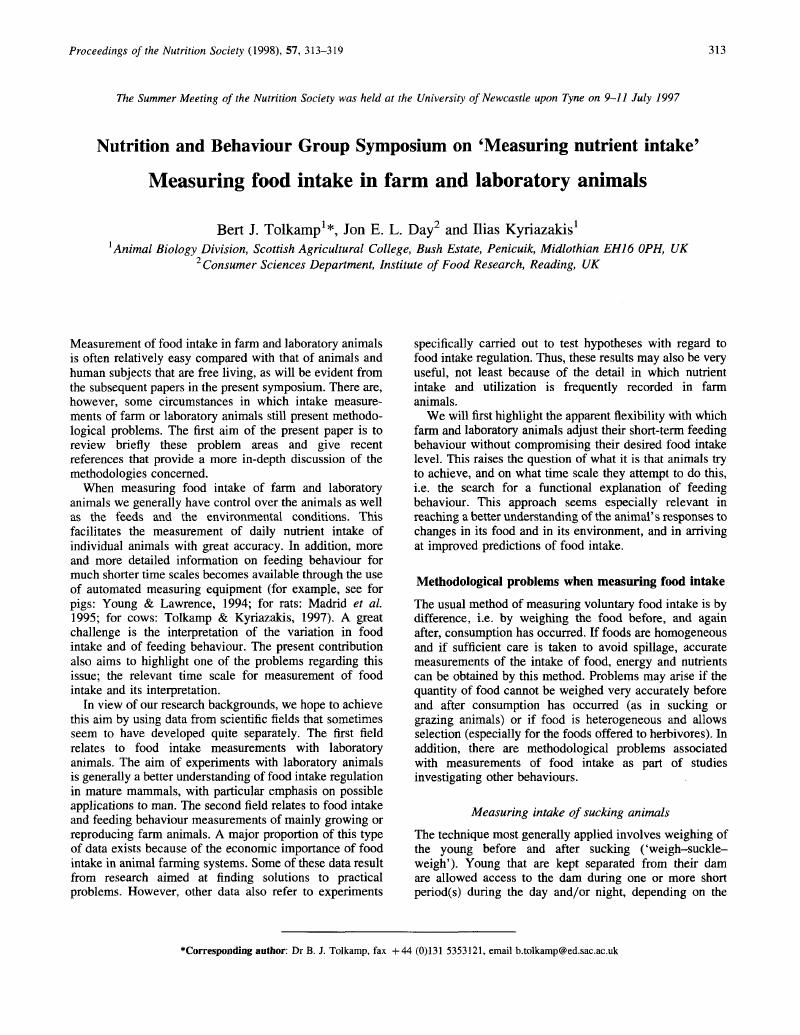Crossref Citations
This article has been cited by the following publications. This list is generated based on data provided by Crossref.
Kyriazakis, Ilias
and
Day, Jon E. L.
1998.
Does the study of feeding behaviour benefit from a teleonomic framework?.
Nutrition Research Reviews,
Vol. 11,
Issue. 2,
p.
223.
Day, Jon E. L.
Kyriazakis, Ilias
and
Rogers, Peter J.
1998.
Food choice and intake: towards a unifying framework of learning and feeding motivation.
Nutrition Research Reviews,
Vol. 11,
Issue. 1,
p.
25.
Tolkamp, B. J.
and
Kyriazakis, I.
1999.
A comparison of five methods that estimate meal criteria for cattle.
Animal Science,
Vol. 69,
Issue. 3,
p.
501.
Tschöp, Matthias
and
Heiman, Mark L.
2001.
Overview of Rodent Models for Obesity Research.
Current Protocols in Neuroscience,
Vol. 17,
Issue. 1,
Tolkamp, Bert J
Emmans, Gerry C
Yearsley, Jonathan
and
Kyriazakis, Ilias
2002.
Optimization of short-term animal behaviour and the currency of time.
Animal Behaviour,
Vol. 64,
Issue. 6,
p.
945.
Howie, J.A.
Tolkamp, B.J.
Bley, T.
and
Kyriazakis, I.
2010.
Short-term feeding behaviour has a similar structure in broilers, turkeys and ducks.
British Poultry Science,
Vol. 51,
Issue. 6,
p.
714.
Nikkhah, Akbar
2014.
Review: Ruminant feed intake regulation evolution: chronophysiological rhythms perspectives.
Biological Rhythm Research,
Vol. 45,
Issue. 4,
p.
563.
Jung, Kanghoon
Jang, Hyeran
Kralik, Jerald D.
Jeong, Jaeseung
and
Faisal, Aldo A.
2014.
Bursts and Heavy Tails in Temporal and Sequential Dynamics of Foraging Decisions.
PLoS Computational Biology,
Vol. 10,
Issue. 8,
p.
e1003759.
Rusakovica, Julija
Kremer, Valentin D.
Plötz, Thomas
Rohlf, Paige
and
Kyriazakis, Ilias
2017.
The genetic basis of novel water utilisation and drinking behaviour traits and their relationship with biological performance in turkeys.
Genetics Selection Evolution,
Vol. 49,
Issue. 1,
Andong, Felix Atawal
Okwuonu, Elijah Sunday
Melefa, Temitope Dadewura
Okoye, Charles Obinwanne
Nkemakolam, Augustine Okorie
Hinmikaiye, Funmilayo Faith
Nwankpo, Emelda Obioma
and
Ozue, Chibike Chisom
2021.
The Consequence of Aqueous Extract of Tobacco Leaves (Nicotiana tabacum. L) on Feed Intake, Body Mass, and Hematological Indices of Male Wistar Rats fed under Equal Environmental Conditions.
Journal of the American College of Nutrition,
Vol. 40,
Issue. 5,
p.
429.
Patón, D.
García-Gómez, J. C.
Loring, J.
and
Torres, A.
2023.
Composting the Invasive Toxic Seaweed Rugulopteryx okamurae Using Five Invertebrate Species, and a Mini-review on Composting Macroalgae.
Waste and Biomass Valorization,
Vol. 14,
Issue. 1,
p.
167.
Yadav, Anupama
Malik, Shalie
and
Rani, Sangeeta
2023.
Food monotony compromises photoperiod induced responses in migratory redheaded bunting.
Avian Biology Research,
Vol. 16,
Issue. 2,
p.
68.



